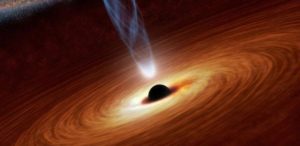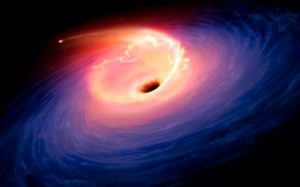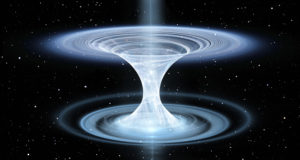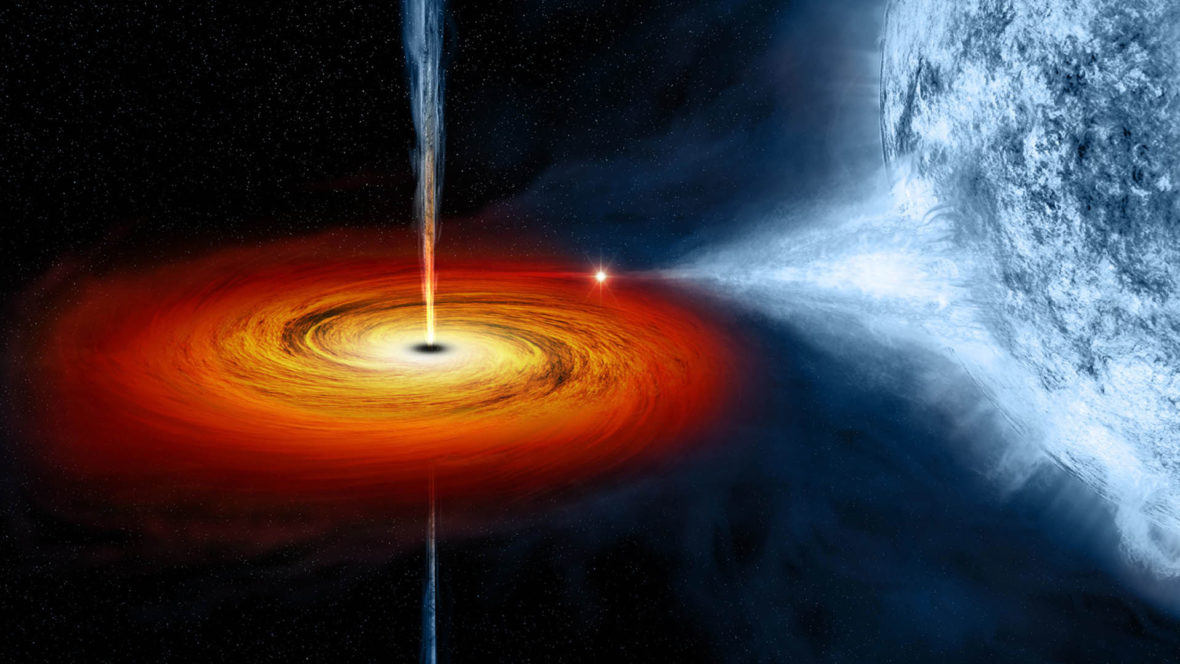Black holes are regions of spacetime exhibiting such a strong gravitational effect that nothing, not even particles and electromagnetic radiation such as light, can escape from inside it. The theory of general relativity predicts that a sufficiently compact mass can deform spacetime to form a black hole. Take a look below for 28 more fascinating and bizarre facts about black holes.
1. Material spirals in to a black hole through an accretion disk, which is a disk of gas, dust, stars and planets that fall into orbiting the black hole.
2. The closer you are to a black hole, the slower time runs. Material that gets too close to a black hole gets sucked in and can never escape.
3. The point of no return around a black hole is called the even horizon. This is the region where the gravity of the black hole overcomes the momentum of material spinning around it in the accretion disk. Once something crosses the event horizon, it can’t ever be pulled out of the black hole; this includes time and light.
4. Black holes were first proposed to exist in the 18th century, but still remained a mathematical curiosity until the first candidate black hole was found in 1964. It was called Cygnus X-1, an x-ray source in the constellation Cygnus.
5. Black holes don’t emit radiation on their own. They’re detected through the radiation that’s given off as material is heated in the accretion disk.

6. Just as a clock runs a bit slower closer to sea level than up on a space station, clocks run very slow or not at all near black holes.
7. Black holes can be infinitely big, or so some scientists believe.
8. Our galaxy is covered in black holes, but the one most likely to destroy Earth is about 1,600 light years away.
9. There is a massive black hole at the very center of the Milky Way galaxy. It’s about 30,000 light years away and is over 30 million times bigger than our Sun.
10. Black holes eventually evaporate. According to some scientists, as black holes emit radiation, they are losing mass. This process has the potential to eventually kill the black hole.
11. At some point, the collapsing core of a black hole becomes even smaller than an atom or an electron, until it eventually reaches its Planck Length. The Planck Length is a quantum size limit that makes it barely measurable.
12. Black holes aren’t funnel shapes, they’re actually spheres.
13. When the core of a star collapses, the star rotates faster and faster while becoming smaller and smaller. When it reaches the point where it doesn’t have enough mass to become a black hole, it gets squeezed together to form a neutron star and continues to spin rapidly. Even when black holes shrink down to Planck Length, it continues to spin rapidly.
14. Black holes distort space itself, and as they continue to spin, that distortion gets just as distorted. Essentially, it’s an infinite regression of distortions.
15. Even though it’s obvious that black holes can’t support life, most people think that if they came close to one they would be crushed. However, if you came close to a black hole, you would most likely get stretched to death because whatever part of your body reaches the event horizon first, will experience significantly more gravity.

16. Although they’re known for being black, they actually do emit electromagnetic radiation which can show up as different colors.
17. In most circumstances, black holes are destructive, however, there have been many theories, studies and suggestions put forth that black holes can actually be harnessed for their energy and for space travel.
18. Black holes can get bigger and bigger as they collide with other black holes, allowing their size to increase infinitely with every collision.
19. Modern astronomers have shown that black holes come in different variations. There are spinning black holes, electrical black holes, and spinning electrical black holes. The type of black hole depends on the amount of energy that it releases when it distorts the space around it.
20. In 1783, a scientist named John Mitchell was the first to develop a theory about black holes after he wondered whether a gravitational force could be so strong that even light particles couldn’t escape it.
21. To have enough gravity to pull light into itself, black holes have to have a massive amount of mass in an extremely small space. This means that black holes have a mass of about 10 to 30 billion times the mass of the Sun.
22. When a black hole pulls something in, its event horizon supercharges the speed of particles close to the speed of light which produces a staticky sound. However, this sound can only be heard with special instruments since the vacuum of space doesn’t allow for sound waves to travel.
23. The only way to escape a black hole is to move faster than the speed of light.
24. Scientists have stated that black holes create elements as they break down matter into subatomic particles. These particles have the ability to create elements heavier than helium, such as iron and carbon, which are essential to the formation of life.

25. Once a mass gets into a black hole, it gets squeezed so hard that its individual components become compressed and eventually break down into subatomic particles. Some scientists theorize that the matter is then ejected in a phenomenon known as a white hole.
26. Technically speaking, stars aren’t the only things that can become black holes. For example, if something as small as a pencil was shrunk down to an infinitely small point and it still retained all of its mass, its density would reach astronomical levels which would make the force of their gravity ridiculously strong.
27. According to modern theories, matter within a black hole is crushed to infinite density, and spacetime ceases to exist. When this happens, the laws of physics break down and don’t apply anymore.
28. Contrary to popular belief that there is a tunnel in the middle of every black hole, all that exists at the center is a massive amount of matter that’s compressed infinitely.




